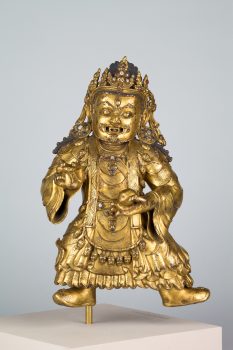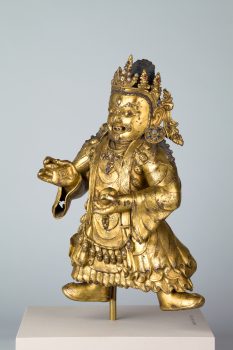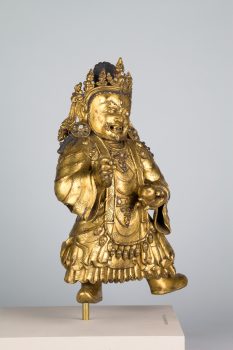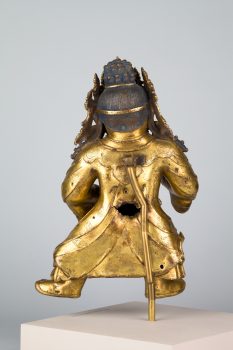Tibet
15th century




Tibet
15th century




This sculpture shows the wrathful deity Mahakala in a form found in practices of the Ancient (Nyingma) tradition of Tibetan Buddhism and originates in the hidden treasure (Tibetan: terma) teachings. He wears a heavy coat and boots and holds a large sandalwood club with both hands in front of his body. His appearance is ferocious, emphasized by his blazing hair that stands on end. The sculpture has been engraved with patterns of auspicious symbols. Vajra, lotuses, clouds, and phoenixes are among six different floral and geometric motifs. The sculpture was inlaid with shaped quartz-crystal cabochons and lapis lazuli along with an unidentified red stone in place of a ruby.
A meditation technique primarily used in tantric practice that involves imagining a deity in one’s mind or imagining oneself becoming a deity and carrying out various activities. Such techniques are intended to help a practitioner transform ordinary perception and achieve enlightened qualities.
Prescribed practices that carry symbolic meaning and value within a specific tradition and are intended to attain a desired outcome. Rituals are usually done as part of a ceremony or regular routine.
Protectors of Buddhist teachings who destroy obstacles that impede the path to enlightenment. The more frightening and gruesome their appearance, the greater their power.
Today, Tibetans primarily inhabit the Tibetan Plateau, situated between the Himalayan mountain range and the Indian subcontinent to the west, Chinese cultural regions to the east, and Mongolian cultural regions to the northeast. During the 7th to 9th century, Tibetan rulers expanded their empire across Central Asia, and established Buddhism as the state religion.
Get the latest news and stories from the Rubin, plus occasional information on how to support our work.